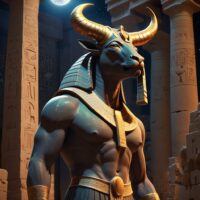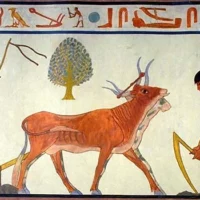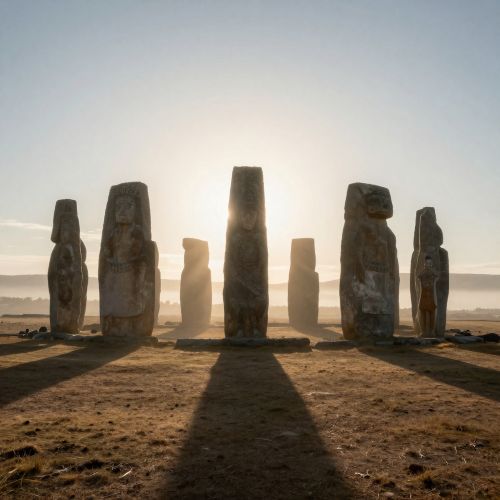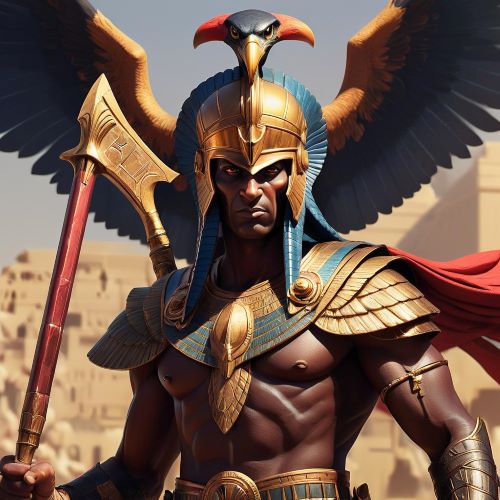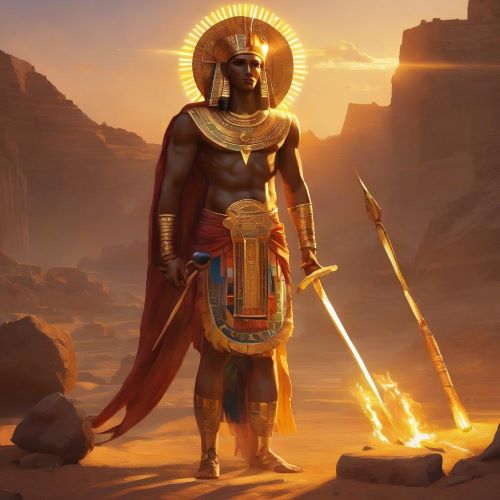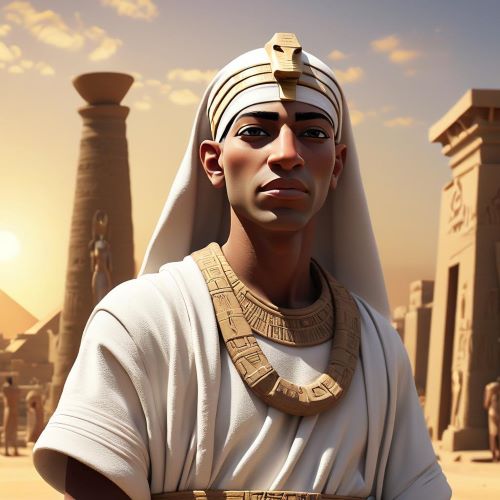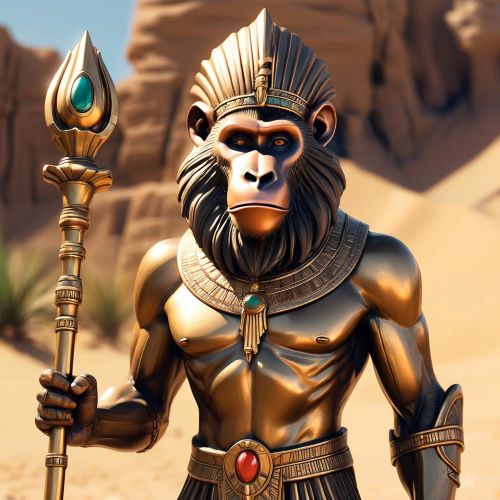
Bata : The Bull God
Listen
At a glance
| Description | |
|---|---|
| Origin | Egyptian Mythology |
| Classification | Gods |
| Family Members | Anubis (Brother) |
| Region | Egypt |
| Associated With | Resurrection, Transformation |
Bata
Introduction
Bata stands as a compelling figure in Egyptian mythology, known for his transformation, spiritual duality, and cosmic symbolism. Often associated with the 17th Upper Egyptian Nome and intricately woven into the “Tale of Two Brothers,” Bata’s myth carries themes of betrayal, death, resurrection, and divine justice. Unlike the more mainstream gods like Osiris or Ra, Bata occupies a unique narrative space—both sacred and deeply symbolic—offering insights into the ancient Egyptian worldview surrounding the soul, morality, and divine intervention.
Physical Traits
In visual and textual depictions, Bata is portrayed through a blend of human and bovine characteristics. Some early representations show him as a mummified ram or bull, reflecting his links to pastoral life and sacred ritual. Others emphasize a hybrid form—human with bovine ears and horns—symbolizing power, fertility, and celestial influence.
Unique among deities, Bata is occasionally shown with two faces, which scholars interpret as a representation of duality: life and death, past and future, or even the two lands of Egypt—Upper and Lower. His rare depictions are often found on amulets, temple artifacts, and sacred instruments such as the sistrum, reinforcing his esoteric and protective attributes.
Family
Bata’s familial role adds emotional depth to his myth. He is most famously known as the younger brother of Anubis, the jackal-headed god of mummification and the afterlife. This relationship is central to the “Tale of Two Brothers,” where the close bond between the siblings is tested through a tragic misunderstanding and betrayal orchestrated by Anubis’s wife.
Bata flees, experiences death, is resurrected, and eventually vindicated. Despite the drama, the story reflects values such as loyalty, divine justice, and cosmic order—central pillars in Egyptian moral and spiritual life. Their brotherhood echoes broader mythological patterns, where fraternal bonds shape the fate of gods and men alike.
Other names
The name “Bata” is thought to be rooted in the ancient Egyptian word “ba,” one of the spiritual components of a person, representing their unique personality or soul essence. The addition of the feminine suffix “-ta” in his name may suggest nurturing or creative aspects, possibly denoting his link to the “giver of the soul.”
Some variations and interpretations also connect him with a deity named “Bt,” suggesting he might be a later evolution of an older funerary god. Additionally, references to Bata as the “Ba of two faces” highlight his cosmic duality, reinforcing his role as a spiritual mediator across planes of existence.
Powers and Abilities
Bata’s divine attributes go far beyond physical transformation. One of the most striking elements of his story is his ability to die and be reborn, not once but multiple times, often linked to parts of his body like the heart or tree symbolism. His myth suggests he can shift into different life forms—a bull, a tree, even flowing water—illustrating his mastery over life cycles and natural elements.
He also exhibits prophetic vision, symbolized through his two faces, implying awareness of both past and future events. These traits place Bata among deities who uphold Ma’at—the principle of balance and cosmic order—serving as a spiritual guardian in both physical and metaphysical realms.
Notably, his myth describes divine intervention by the Ennead—the council of principal gods—who take pity on him and ultimately restore his life. This suggests that Bata held enough spiritual weight to command attention and action from the highest divine order in Egyptian theology.
Modern Day Influence
Though Bata is not as frequently referenced as deities like Isis or Horus in modern Egyptology, his mythological footprint is substantial in academic circles. His story appears in texts like the Papyrus Jumilhac and has been the subject of scholarly interpretation due to its moral complexity and symbolic richness.
Modern cultural references to Bata are mostly confined to academic and literary domains. However, the name “Bata” is recognized today worldwide due to the Bata Shoe Company, a Czech-origin brand that shares the name coincidentally. While there’s no relation between the brand and the deity, the overlap often sparks curiosity among those familiar with Egyptian mythology.
Bata’s tale also fits within broader global motifs of the dying and resurrected god, seen in mythologies across Mesopotamia, Greece, and Mesoamerica, reinforcing his place within the universal archetypes of spiritual transformation and moral reckoning.
Related Images
Source
Geraldine Pinch. Egyptian Mythology: A Guide to the Gods, Goddesses, and Traditions of Ancient Egypt.
The Ancient Egyptian Tale of Two Brothers. Oxbow Books.
William Matthew Flinders Petrie. Egyptian Tales. Cambridge University Press.
Bata | Camp Half-Blood Fanon Wiki | Fandom. (2025). https://camphalf-bloodfanon.fandom.com/wiki/Bata
Bata – 𓏞𓀀 Sesh Kemet Egyptian Scribe 𓆎𓅓𓏏𓊖. (n.d.). https://seshkemet.weebly.com/bata.html
Bata | Myth and Folklore Wiki – Fandom. (n.d.). https://mythus.fandom.com/wiki/Bata
Contributors to Wikimedia projects. (n.d.). Bata (god) – Wikipedia. https://en.wikipedia.org/wiki/Bata_(god)
Frequently Asked Questions
What is lorem Ipsum?
I am text block. Click edit button to change this text. Lorem ipsum dolor sit amet, consectetur adipiscing elit. Ut elit tellus, luctus nec ullamcorper mattis, pulvinar dapibus leo.
What is lorem Ipsum?
I am text block. Click edit button to change this text. Lorem ipsum dolor sit amet, consectetur adipiscing elit. Ut elit tellus, luctus nec ullamcorper mattis, pulvinar dapibus leo.
What is lorem Ipsum?
I am text block. Click edit button to change this text. Lorem ipsum dolor sit amet, consectetur adipiscing elit. Ut elit tellus, luctus nec ullamcorper mattis, pulvinar dapibus leo.
What is lorem Ipsum?
I am text block. Click edit button to change this text. Lorem ipsum dolor sit amet, consectetur adipiscing elit. Ut elit tellus, luctus nec ullamcorper mattis, pulvinar dapibus leo.
What is lorem Ipsum?
I am text block. Click edit button to change this text. Lorem ipsum dolor sit amet, consectetur adipiscing elit. Ut elit tellus, luctus nec ullamcorper mattis, pulvinar dapibus leo.


